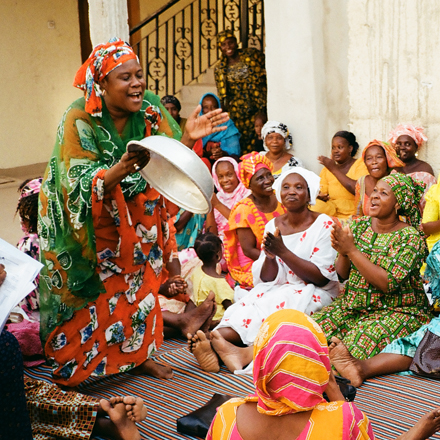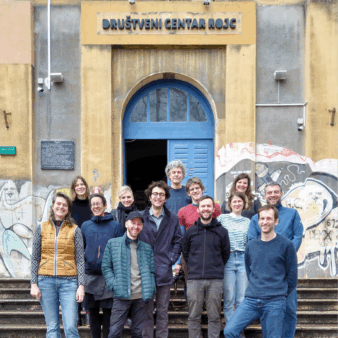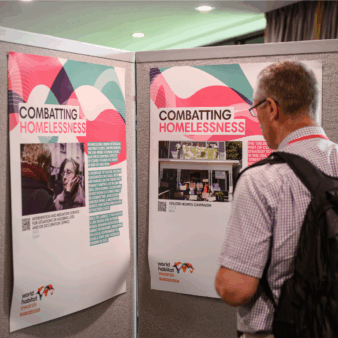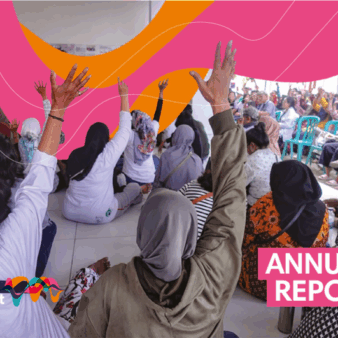
Anne-Lize Hertgers, Eloise Pelaud and Bea Varnai are part of urbaMonde, a French-Swiss organisation that supports organised communities in carrying out community-led housing projects and implementing the right to the city and to adequate housing.
Throughout the world, the right to decent housing, an inalienable human right, is far from being a reality for far too many people. The experience on the ground shows that the residents of disadvantaged communities lack access to land and financing to carry out their housing projects. Vulnerable communities are often excluded from housing finance by private or public financial and microfinance institutions, due to either exclusive entry requirements or the unaffordability of those products. In many contexts, and particularly across Africa, housing finance is poorly developed and collective housing ownership models are excluded from housing subsidies.
However, the Center for Affordable Housing Finance, urbaMonde and urbaSEN have worked together to document experiences of affordable housing production programmes and projects across Africa, focusing on their financial design. Ten examples of affordable financing mechanisms, built on diverse levels of community ownership, were analysed.
These are:
- Cameroon – Alternative Program for Social Housing
- Gambia – Cement Block Banking
- Kenya – Akiba Mashinani Trust
- Kenya – Nyumba Smart Microloans
- Mauritania – Twize
- Mozambique – Inhamizua REALL
- Namibia – Twahangana Fund
- Senegal – Revolving Fund for Urban Renewal
- South Africa – Khayelitsha People’s Housing Process
- Zimbabwe – Gungano Urban Poor Fund
They highlight several important lessons to improve existing financing mechanisms for housing and to introduce innovations to the affordable housing sector in African countries.
They also showcase some of the key conditions for making housing genuinely affordable.
The importance of partnerships and the diversity of funding sources
All ten examples demonstrate the importance of support structures, such as technical assistance schemes and strategic partnerships, to strengthen local communities in the implementation of their housing projects.
The consolidation of enabling legal, institutional and financial frameworks, as well as providing direct support to residents, helps increase their negotiating capacity with public and financial institutions, and encourages investments in housing and land.
Public-private-people partnerships attract further funds to help scale projects and subsidise non-financial services such as technical assistance, financial education and community empowerment. Combining several funding sources means increasing the investment and securing it in the longer term. Inspiring examples for this include the partnerships developed by the social enterprise and real estate developer Casa Real in Mozambique, which aims to ‘design, build and sell [homes] people can afford’. They achieve this by working with:
- Reall as the social investor for housing development;
- the Municipality of Beira as public partners providing land, access to services and planning assistance; and
- the Government of the Netherlands through the creation of a master plan and support to advocate with banks – such as Asba – who became the first bank to offer financial products to buyers of Casa Real homes.
So far the results include 21 affordable (sold) homes, and a total of 80 planned through either employer-guaranteed mortgages or a hire-purchase programme.
Other examples worth looking into include the alternative social housing programme in Cameroon and the People’s Housing Process in South Africa.
Housing as a process
Examples, such as the Nyumba Smart Loan housing microfinance schemes developed by Habitat for Humanity and its partners in Kenya – the Twize programme in Mauritania and the Khayelitsha People’s Housing process in South Africa – as well as experiences of organised communities in Namibia, Zimbabwe and Senegal, illustrate the importance of embracing housing as a process and to consider the entire housing value chain, not only the access to finance, but also access to labour, affordable and sustainable housing materials, adapted skills and adequate public services.
In Kenya, this has led to ‘a significant increase in the overall quality of housing conditions, specifically the quality of the walls and roofs, the number of rooms, and the quality of building materials’[1]. It also led to self-reported improvements in families’ health outcomes thanks to investment in water and sanitation. One of the residents claims: “I used to fear taking loans as I heard people saying that if you borrowed money you could lose everything. Now when I sit here in my home and look around, I am so very proud.”
Housing construction costs can be reduced through a variety of ways, including:
- the design of collective housing solutions (see case studies from Zimbabwe, Mozambique and Namibia);
- the establishment of production units for local building materials (refer to the Gambia, Cameroon and Senegal); and
- the incremental upgrading of public or municipal infrastructures and services (see case studies from Zimbabwe, South Africa and the Akiba Mashinani Trust in Kenya).
[1] Building Assets, Unlocking Access: KWFT Housing Microfinance Impact Evaluation Final Report, 2018. https://www.findevgateway.org/paper/2018/06/building-assets-unlocking-access-kwft-housing-microfinance-impact-evaluation-final
Introducing these cost-saving measures are best achieved when understood and approved by community members. In Zimbabwe cost-saving designs included semi-detached housing, shared walls and incremental approaches to improving communal services. However, this proved to be a challenge as not everyone initially embraced these design concepts, but through increased involvement in the architectural plans, results were achieved that ensured affordability and also fulfilled the community’s wishes.
The role of residents
As in Zimbabwe, the involvement of residents appears to be a key element in the production of affordable housing. Community members taking responsibility for various activities and functions within the housing process does not only contribute to reducing costs but also strengthens local capacities and social cohesion.
Savings, whether individual or collective, can significantly contribute to building the financial capacities and autonomy of organised communities, and increase their negotiation power. In fact, savings are an important leverage for communities and individuals to mobilise market-based finance and public subsidies that enable them to implement their housing projects. The results can be life-changing, as one of the residents involved in the community-managed Twahangana Fund, in Namibia, explains: “I feel only happiness. I never thought that I would one day live in a brick house. My first born – who is now 31 years old – was born in a shack in the informal settlement. It took us years to get this far, sometimes we gave up, but then we again encouraged each other.”
We are still a long way off from realising the basic human right to adequate housing for all, however, the different lessons learnt show the dedication and importance of communities to mobilise finance and develop mechanisms. Mbolo Moy Dole! Unity is strength!
Read the full study here.
Image: Damien Epiney




Join the discussion